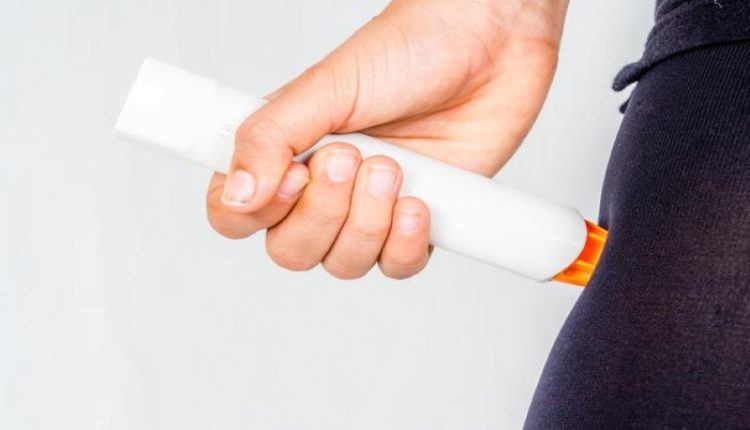
Anaphylaxis and allergies, adrenalin auto-injectors: a complete guide
Anaphylaxis and adrenaline auto-injectors, a complete guide: anaphylaxis is an extremely severe allergic reaction
Reactions usually start within a few minutes and progress rapidly, but can occur up to 2-3 hours after exposure.
Common allergens include food and insect bites.
Anaphylaxis can progress rapidly and failure to administer adrenaline in a timely manner has been associated with deaths.
Many children at risk of anaphylaxis are prescribed adrenaline auto-injectors (AAIs) by their doctor
These devices should be quickly accessible to them at all times.
AAIs provide a potentially life-saving dose of adrenaline in the event of a severe allergic reaction (anaphylaxis).
Why does anaphylaxis occur?
The body’s immune system reacts to a substance that it mistakenly perceives as a threat.
It produces an ‘allergy’ antibody called immunoglobulin E (IgE), which attaches itself to the substance (‘allergen’) and causes the release of chemicals including histamine.
Histamine dilates the capillaries in the skin, causing an itchy rash, swelling and reddening of the skin.
A drop in blood pressure leaves the victim dizzy, light-headed and in danger of collapsing.
In extreme cases, the allergic reaction can progress into a life-threatening reaction within minutes.
The treatment of anaphylaxis consists of administering adrenaline (usually using an auto-injector) by injection into the outer mid-thigh muscle.
Adrenaline treats the symptoms and prevents them from worsening.
Other ‘allergy’ drugs, such as antihistamines, can help with mild symptoms but are not effective for severe reactions (anaphylaxis).
This is because they only reduce the release of histamine and take up to 30 minutes to act, which may be too late.
How many doses of adrenaline should be administered?
The administration of adrenaline can be life-saving, but more than one dose may be required.
Some anaphylactic reactions require more than a single dose of adrenaline.
It is therefore essential to always dial the Emergency Number and request an ambulance whenever a severe anaphylactic reaction occurs.
A second adrenaline auto-injector can be administered 5 minutes after the first one, but feedback from the operations centre or your doctor may be advisable.
Adrenaline can be safely administered by non-health workers as an injection into the muscle using an adrenaline auto-injector (AAI)
Current brands available in Western countries are EpiPen®, Emerade®, Jext®.
School personnel should ideally have received adequate training to be safe to administer the drug.
Always administer adrenaline FIRST to someone with a known food allergy who has sudden breathing difficulties.
Before other medicines such as asthma inhalers and even if there are no skin symptoms.
Delays in administering adrenaline are a common occurrence in fatal reactions.
IF IN CASE OF DOUBT, give adrenaline.
For non-life-threatening reactions or localised swelling that does not impair breathing administer an antihistamine, such as Piriton.
The antihistamine tablets or elixir will take about 15 minutes to take effect.
If you have the latest version of Epipen, it is no longer necessary to hold down for 10 seconds: just 2 seconds will be enough.
However, holding it down for longer will do no harm and there is such a problem with the supply that people are not sure which version they have!
Emerade: 150, 300 and 500 microgram doses are available and the 500 mcg dose has a longer needle to allow deeper penetration of the fat for older children
Epipen: 150 and 300 microgram doses are available. Epipen Junior delivers a 150 microgram dose
Jext: 150 and 300 microgram doses available
Pharmaceutical companies have also advised the use of their auto-injectors beyond the expiry date if it is recent
Previous advice has been that adrenaline deteriorates and becomes less potent beyond the expiry date.
Manufacturers have issued occasional guidance arising from these supply problems, indicating that certain doses of auto-injectors can be used up to 3 months after the indicated expiry date.
Before using the adrenalin auto-injector, it is essential to check in the window that the solution remains clear and colourless.
In response to the shortages, the Anaphylaxis Campaign issued the following advice;
If you are prescribed an alternative AAI device, make sure you know how to use it and train others who may need to use it in an emergency.
Always carry two adrenaline auto-injectors with you.
Make sure you have recorded the expiry date of your devices on the relevant manufacturers’ websites to give you ample warning when a new prescription is needed.
Make sure you obtain a replacement device before disposing of any expired devices.
Always make sure you have a training device that can be ordered free of charge from the manufacturer’s websites.
Read Also
Emergency Live Even More…Live: Download The New Free App Of Your Newspaper For IOS And Android
Anaphylactic Shock: What It Is, Symptoms, Diagnosis And Treatment
What Is And How To Read The Allergy Patch Test
Allergies: New Drugs And Personalised Treatment
When Can We Talk About Occupational Allergies?
Nickel Allergy: What Objects And Foods To Avoid?
Food Allergies: Causes And Symptoms
Allergies To Stinging Insects: Anaphylactic Reactions To Wasps, Polistines, Hornets, Bees
Anaphylactic Shock: What It Is And How To Deal With It
Wasp Sting And Anaphylactic Shock: What To Do Before The Ambulance Arrives?
Anaphylactic Shock: Symptoms And What To Do In First Aid
Adverse Drug Reactions: What They Are And How To Manage Adverse Effects
Symptoms And Remedies Of Allergic Rhinitis
Allergic Conjunctivitis: Causes, Symptoms And Prevention
Allergic Contact Dermatitis And Atopic Dermatitis: The Differences
Spring Arrives, Allergies Return: Tests For Diagnosis And Treatment
Symptoms And Foods To Avoid With Nickel Allergy
Contact Dermatitis: Can A Nickel Allergy Be The Cause?
Respiratory Allergies: Symptoms And Treatment



